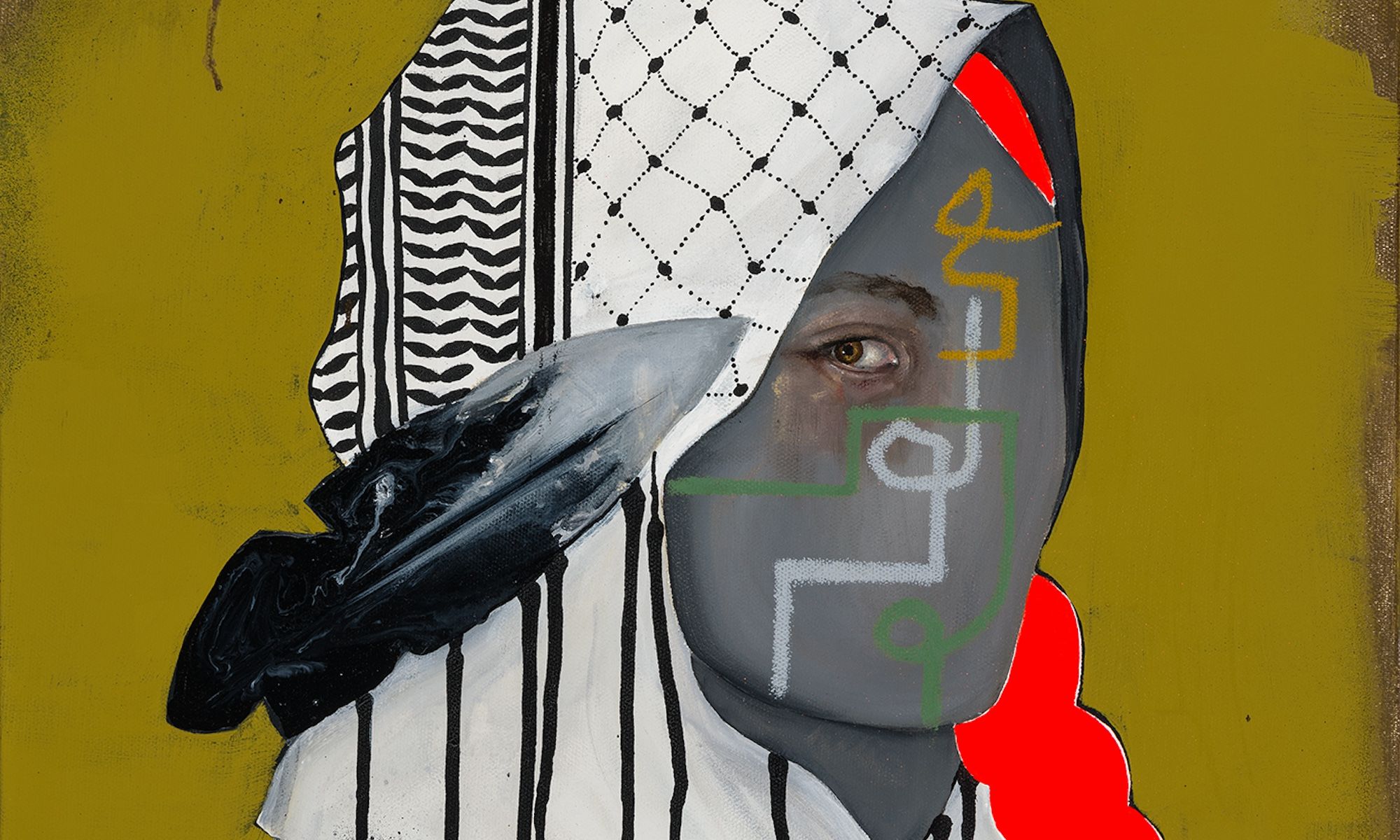Danielle SeeWalker, G for Genocide, 2024, acrylic, aerosol, oil stick on canvas Courtesy the artist
The artist Danielle SeeWalker, a Húŋkpapȟa Lakȟóta citizen of the Standing Rock Sioux Nation based in Denver, incorporates traditional Native American materials and messages into her work. Her murals are found throughout Colorado, her work on the non-profit storytelling platform Red Road Project received national coverage and she currently has a solo show (until 15 September) at the History Colorado Center. In January, she was invited to be an artist in residence this summer in the luxe Rocky Mountain resort town of Vail, Colorado, through the municipality’s Art in Public Places (AIPP) programme, an offer that included housing, a stipend and several public events. But after she posted an image on Instagram of her painting G is for Genocide (2024), depicting a woman wearing a keffiyeh—widely seen as a symbol of support for Palestine, particularly since Israel launched its war in Gaza following the Hamas terror attack of 7 October 2023—Vail rescinded the offer.
According to SeeWalker, AIPP’s coordinator Molly Eppard told her that the Jewish community of Vail was extremely upset by the painting, which she had made for a group show at Ryan Joseph Gallery in Denver. “It was for a different exhibition and had nothing to do with Vail or the residency,” says SeeWalker, adding that she declined another residency and other exhibition opportunities so she could take the AIPP residency, only to have it cancelled without discussion.
The Art Newspaper’s calls to AIPP and municipal officials in Vail were not answered. The municipality issued a statement about the decision on 9 May. “The town of Vail’s Art in Public Places (AIPP) is not moving forward with its summer artist in residency and related programmes,” it reads in part. “The decision was made after concerns arose around the potential politicising of the public art programme.”
Installation view of Danielle SeeWalker: But We Have Something to Say at the History Colorado Center, until 15 September Courtesy the History Colorado Center
The statement continues: “While the Town of Vail embraces [SeeWalker’s] messaging and artwork surrounding Native Americans, in recent weeks her art and her public messaging has focused on the Israel/Gaza crisis. While the programmes around a two-week residency were being planned, a proposal for her mural was never submitted, nor approved and therefore no contract was issued. AIPP’s mission is to create a diverse and meaningful public art experience in Vail, but to not use public funds to support any position on a polarising geopolitical issue.”
The statement implies that negotiations with SeeWalker were never finalised and the invitation-only residency, which was scheduled to start in June, was still under consideration. However, materials reviewed by The Art Newspaper show that SeeWalker received written commitments for housing and supplies. An announcement about her arrival in Vail that had been posted on the municipality’s website has since been taken down.
In a subsequent statement on 14 May, the municipality apologised for its handling of the situation. "It was premature to have announced the residency before a mural had been proposed and a contract put in place. That’s on us. And we sincerely apologise for the inconvenience," the statement reads in part. "If Ms. SeeWalker would like to discuss expense reimbursement incurred while preparing for the residency, we will speak with her." SeeWalker says she has attempted to reach the municipality by phone and email but received no response.
The artist says that she and the municipality agreed that her proposal for the mural that was to be part of the residency programme would be submitted after the contract was executed. The mural could be approved, declined or adjusted after submission, but no preliminary requirements were expressed. “I asked [Eppard] several times what the community would like to see or what they don’t want to see,” SeeWalker says. “She told me I have full creative control.”
Danielle SeeWalker, Still Here, 2021, downtown Denver Courtesy the artist
The seven-member board of AIPP meets regularly and publishes the minutes of those meetings. As of this writing, its last meeting was on 6 May, three days before SeeWalker says she received the call from the deputy town manager Kathleen Halloran notifying her that the municipality would be rescinding the offer. The 6 May board minutes reiterate a commitment to hosting SeeWalker, implying that conversations and decisions to the contrary either occurred outside the public meeting or beyond the scope of the board.
Michael Chavez, the manager of the public art programme and collection for Denver Arts and Venues, says there should be no surprises by the time an artist and artwork are selected for a public programme. “Our process of selecting artists is thorough,” he says. “There are micro-community panels, then a technical advisory committee and the commission of cultural affairs, which is a 24-person panel appointed by the mayor, then the mayor. It all makes the selection fair and transparent.” Chavez estimates 50 people review each Denver Arts and Venues project before there is a contract with the artist. He adds: “I can’t imagine a scenario where we would pull an opportunity from an artist for speaking their mind.”
Despite the rescinded AIPP residency invitation, SeeWalker will be in Vail next month to speak at the Vail Symposium, a non-profit “think tank”, on 19 June. Megan McGee Bonta, programme manager for the Vail Symposium, says the organisation welcomes challenging conversations.

